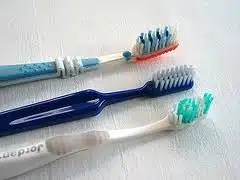
Basic Oral Prevention Saves Lives
Do you put on a seat belt when you drive?
If so, why?
My guess is that it is either because you are compelled to do so by law, or (if you live in the U.S.) you believe the National Highway Traffic Safety Administration (NHTSA), who claim that seat belts save about 13,000 lives a year, nationwide.
The few seconds it takes you to snap on your seat belt buckle reduces the chance of dying in a car crash by 45%, and of being injured by about half. Nevertheless, seat belts are not likely to play a big role in saving your life, because chances are you won’t find yourself in a serious automobile accident. Let’s face it, fortunately, most people never find themselves in that circumstance.
On the other hand, gum disease (either gingivitis or periodontal disease) affects up to 80 percent of the population.
In other articles, you may have heard that periodontal disease is the leading cause of tooth loss among adults. The shocking reality is that this is probably the least notable consequence of periodontal disease.
Periodontal disease is a significant risk factor for stroke, heart disease, certain respiratory problems, low birth-weight infants, and some forms of cancer.
While very few people will die in a car crash, a great deal more will die from a heart attack, stroke, or cancer. Addressing periodontal disease via preventive techniques can significantly reduce your chances of dying from any one of these afflictions.
If this simple logic is not enough to convince you of the need to brush after meals, floss daily and eat a healthy diet, it may help you to know that over the past few decades, there have been hundreds of peer-reviewed medical studies published in journals showing periodontal disease to be a risk factor for heart attacks.
While periodontal disease is certainly not the only factor in the occurrence of cardiovascular diseases or cancer, there is definitely a link. The modern thinking regarding the connection has to do with the long-term inflammatory nature of gum disease. In simple terms, periodontal disease is a bacterial infection of the gums and bone supporting the teeth. As with most any infection in the body, this leads to inflammation.
Often having no symptoms that are detectable by the patient, bacteria from periodontal disease can affect blood vessels on the walls of your heart. If you have gum disease, the bacteria can easily invade the blood stream through one of many open portals. Let’s face it, it is a relatively short trip from the mouth to the heart after all.
Bacteria in the blood may also stimulate liver production of C-reactive proteins and fibrinogen. Both these substances have been linked to heart attacks.
Persons who successfully treated their periodontal disease have also been shown to experience improved cholesterol levels and demonstrated lowered blood pressure. Most readers will recognize these as factors frequently associated with cardiovascular disease.
The bottom line: while we generally don’t hesitate to snap on a seat belt because it may save our lives, not enough of the population understand that oral health basics save more lives than buckling-up! Added benefits? Saving teeth (which leads to better digestion and less need for heartburn medications), fresher breath, and avoiding painful toothaches or complicated dental procedures — which also translates to more dollars in your pocket.








